Citroen C4 2014 2.G Owner's Manual
Manufacturer: CITROEN, Model Year: 2014, Model line: C4, Model: Citroen C4 2014 2.GPages: 340, PDF Size: 28.99 MB
Page 211 of 340
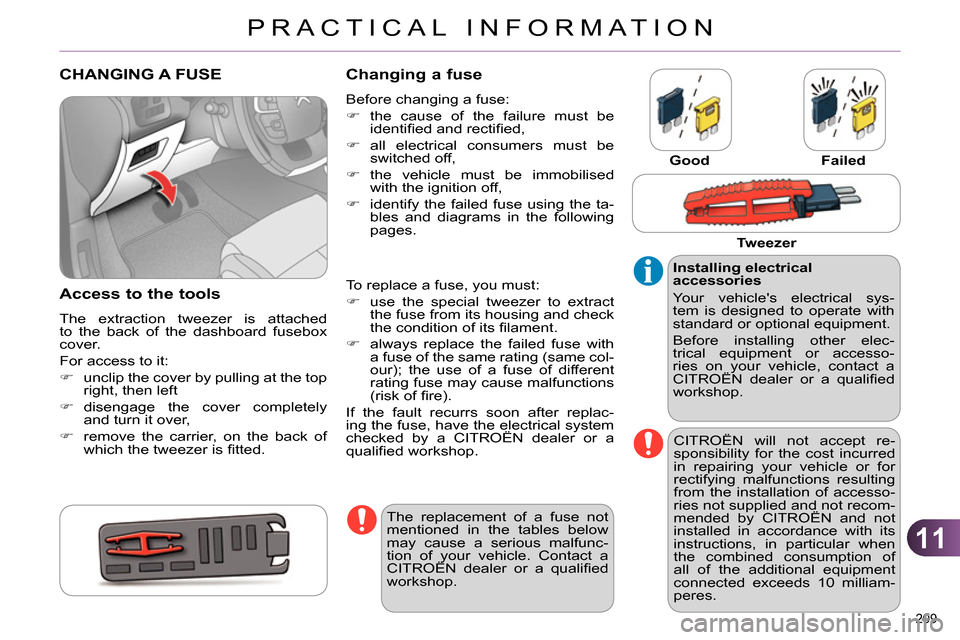
11
PRACTICAL INFORMATION
209
CHANGING A FUSE
Access to the tools
The extraction tweezer is attached
to the back of the dashboard fusebox
cover.
For access to it:
unclip the cover by pulling at the top
right, then left
disengage the cover completely
and turn it over,
remove the carrier, on the back of
which the tweezer is fi tted.
Changing a fuse
Before changing a fuse:
the cause of the failure must be
identifi ed and rectifi ed,
all electrical consumers must be
switched off,
the vehicle must be immobilised
with the ignition off,
identify the failed fuse using the ta-
bles and diagrams in the following
pages.
Good
Failed
To replace a fuse, you must:
use the special tweezer to extract
the fuse from its housing and check
the condition of its fi lament.
always replace the failed fuse with
a fuse of the same rating (same col-
our); the use of a fuse of different
rating fuse may cause malfunctions
(risk of fi re).
If the fault recurrs soon after replac-
ing the fuse, have the electrical system
checked by a CITROËN dealer or a
qualifi ed workshop.
Installing electrical
accessories
Your vehicle's electrical sys-
tem is designed to operate with
standard or optional equipment.
Before installing other elec-
trical equipment or accesso-
ries on your vehicle, contact a
CITROËN dealer or a qualifi ed
workshop.
CITROËN will not accept re-
sponsibility for the cost incurred
in repairing your vehicle or for
rectifying malfunctions resulting
from the installation of accesso-
ries not supplied and not recom-
mended by CITROËN and not
installed in accordance with its
instructions, in particular when
the combined consumption of
all of the additional equipment
connected exceeds 10 milliam-
peres.
The replacement of a fuse not
mentioned in the tables below
may cause a serious malfunc-
tion of your vehicle. Contact a
CITROËN dealer or a qualifi ed
workshop.
Tweezer
Page 212 of 340
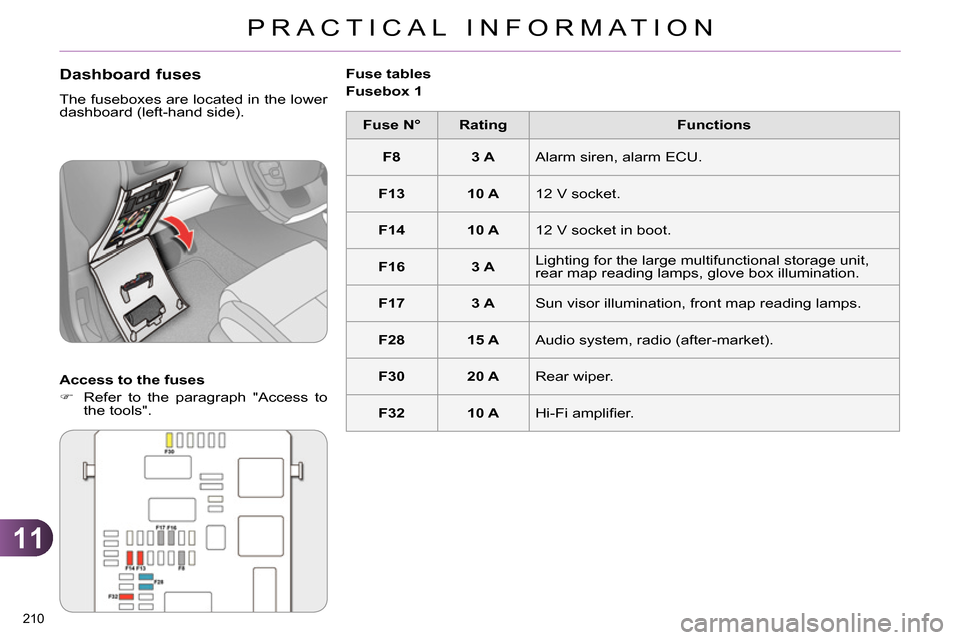
11
PRACTICAL INFORMATION
210
Dashboard fuses
The fuseboxes are located in the lower
dashboard (left-hand side).
Access to the fuses
Refer to the paragraph "Access to
the tools".
Fuse tables
Fusebox 1
Fuse N°
Rating
Functions
F8
3 A
Alarm siren, alarm ECU.
F13
10 A
12 V socket.
F14
10 A
12 V socket in boot.
F16
3 A
Lighting for the large multifunctional storage unit,
rear map reading lamps, glove box illumination.
F17
3 A
Sun visor illumination, front map reading lamps.
F28
15 A
Audio system, radio (after-market).
F30
20 A
Rear wiper.
F32
10 A
Hi-Fi amplifi er.
Page 213 of 340

11
PRACTICAL INFORMATION
211
Fuse N°
Rating
Functions
F36
15 A
Rear 12 V socket.
F37
-
Not used.
F38
-
Not used.
F39
-
Not used.
F40
25 A
230 V / 50 Hz socket.
Fusebox 2
Page 214 of 340
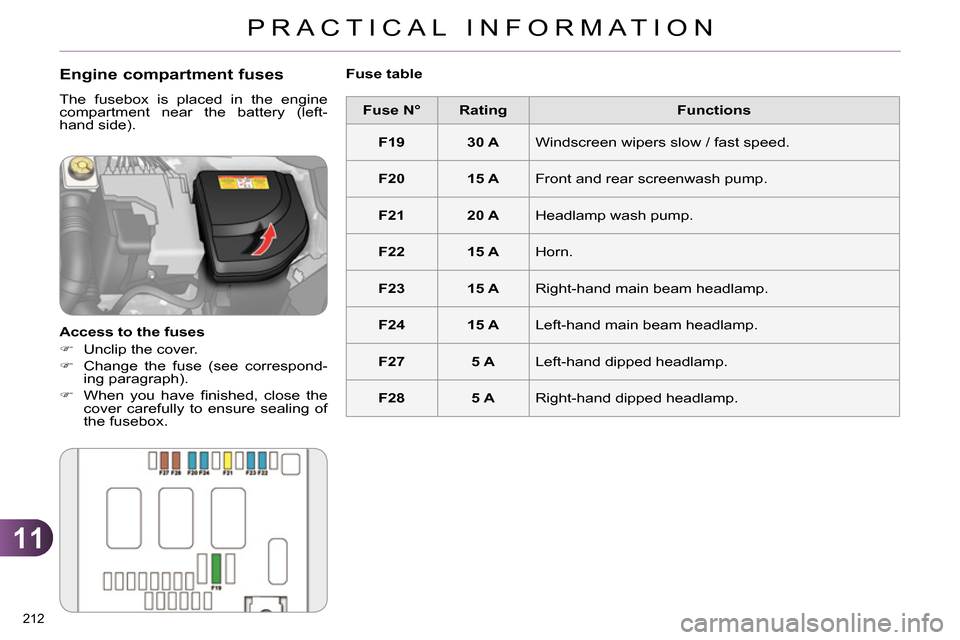
11
PRACTICAL INFORMATION
212
Fuse N°
Rating
Functions
F19
30 A
Windscreen wipers slow / fast speed.
F20
15 A
Front and rear screenwash pump.
F21
20 A
Headlamp wash pump.
F22
15 A
Horn.
F23
15 A
Right-hand main beam headlamp.
F24
15 A
Left-hand main beam headlamp.
F27
5 A
Left-hand dipped headlamp.
F28
5 A
Right-hand dipped headlamp.
Engine compartment fuses
The fusebox is placed in the engine
compartment near the battery (left-
hand side).
Access to the fuses
Unclip the cover.
Change the fuse (see correspond-
ing paragraph).
When you have fi nished, close the
cover carefully to ensure sealing of
the fusebox.
Fuse table
Page 215 of 340
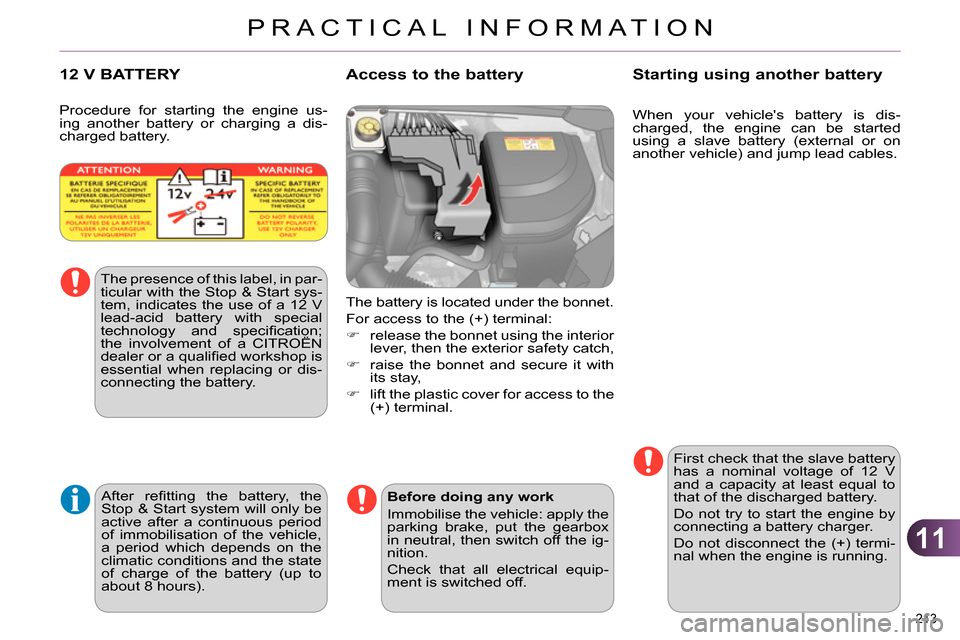
11
PRACTICAL INFORMATION
213
When your vehicle's battery is dis-
charged, the engine can be started
using a slave battery (external or on
another vehicle) and jump lead cables.
Starting using another battery
12 V BATTERY
The battery is located under the bonnet.
For access to the (+) terminal:
release the bonnet using the interior
lever, then the exterior safety catch,
raise the bonnet and secure it with
its stay,
lift the plastic cover for access to the
(+) terminal.
Access to the battery
The presence of this label, in par-
ticular with the Stop & Start sys-
tem, indicates the use of a 12 V
lead-acid battery with special
technology and specifi cation;
the involvement of a CITROËN
dealer or a qualifi ed workshop is
essential when replacing or dis-
connecting the battery.
Procedure for starting the engine us-
ing another battery or charging a dis-
charged battery.
After refi tting the battery, the
Stop & Start system will only be
active after a continuous period
of immobilisation of the vehicle,
a period which depends on the
climatic conditions and the state
of charge of the battery (up to
about 8 hours).
First check that the slave battery
has a nominal voltage of 12 V
and a capacity at least equal to
that of the discharged battery.
Do not try to start the engine by
connecting a battery charger.
Do not disconnect the (+) termi-
nal when the engine is running.
Before doing any work
Immobilise the vehicle: apply the
parking brake, put the gearbox
in neutral, then switch off the ig-
nition.
Check that all electrical equip-
ment is switched off.
Page 216 of 340
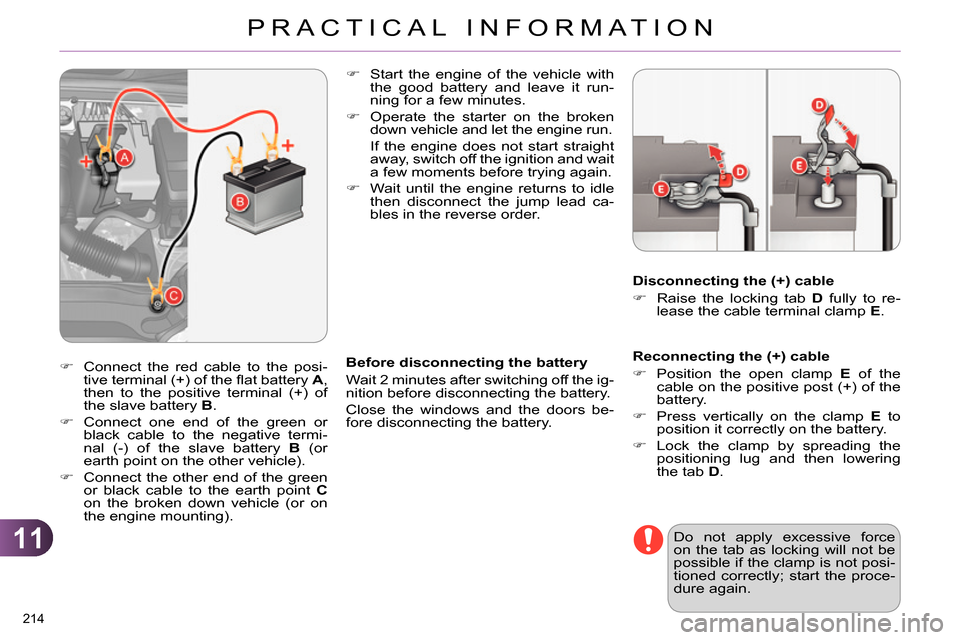
11
PRACTICAL INFORMATION
214
Reconnecting the (+) cable
Position the open clamp E
of the
cable on the positive post (+) of the
battery.
Press vertically on the clamp E
to
position it correctly on the battery.
Lock the clamp by spreading the
positioning lug and then lowering
the tab D
.
Start the engine of the vehicle with
the good battery and leave it run-
ning for a few minutes.
Operate the starter on the broken
down vehicle and let the engine run
.
If the engine does not start straight
away, switch off the ignition and wait
a few moments before trying again.
Wait until the engine returns to idle
then disconnect the jump lead ca-
bles in the reverse order.
Before disconnecting the battery
Wait 2 minutes after switching off the ig-
nition before disconnecting the battery.
Close the windows and the doors be-
fore disconnecting the battery.
Disconnecting the (+) cable
Raise the locking tab D
fully to re-
lease the cable terminal clamp E
.
Do not apply excessive force
on the tab as locking will not be
possible if the clamp is not posi-
tioned correctly; start the proce-
dure again.
Connect the red cable to the posi-
tive terminal (+) of the fl at battery A
,
then to the positive terminal (+) of
the slave battery B
.
Connect one end of the green or
black cable to the negative termi-
nal (-) of the slave battery B
(or
earth point on the other vehicle).
Connect the other end of the green
or black cable to the earth point C
on the broken down vehicle (or on
the engine mounting).
Page 217 of 340
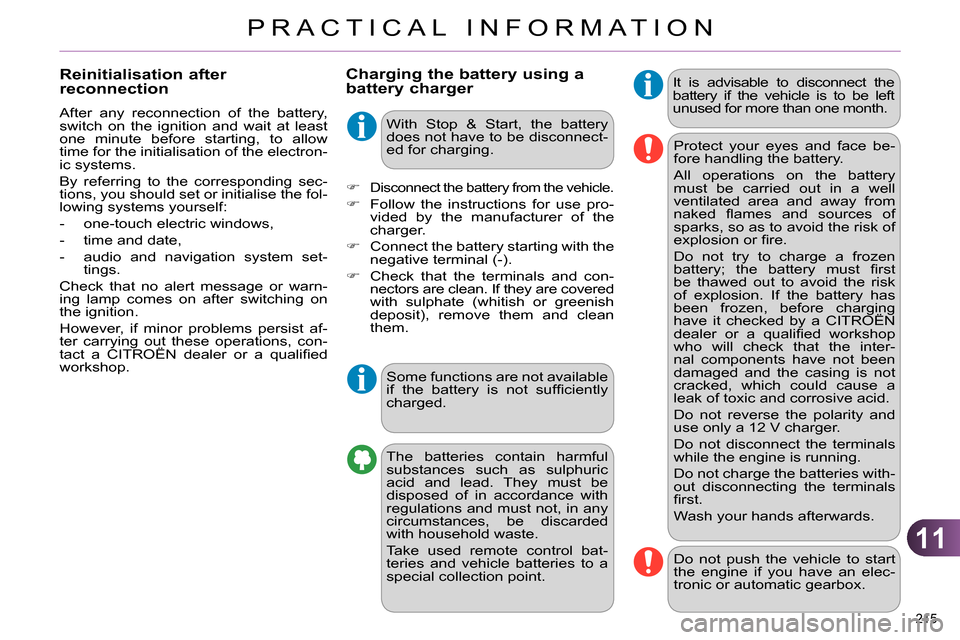
11
PRACTICAL INFORMATION
215
Charging the battery using a
battery charger
It is advisable to disconnect the
battery if the vehicle is to be left
unused for more than one month.
The batteries contain harmful
substances such as sulphuric
acid and lead. They must be
disposed of in accordance with
regulations and must not, in any
circumstances, be discarded
with household waste.
Take used remote control bat-
teries and vehicle batteries to a
special collection point.
Disconnect the battery from the vehicle.
Follow the instructions for use pro-
vided by the manufacturer of the
charger.
Connect the battery starting with the
negative terminal (-).
Check that the terminals and con-
nectors are clean. If they are covered
with sulphate (whitish or greenish
deposit), remove them and clean
them.
Protect your eyes and face be-
fore handling the battery.
All operations on the battery
must be carried out in a well
ventilated area and away from
naked fl ames and sources of
sparks, so as to avoid the risk of
explosion or fi re.
Do not try to charge a frozen
battery; the battery must fi rst
be thawed out to avoid the risk
of explosion. If the battery has
been frozen, before charging
have it checked by a CITROËN
dealer or a qualifi ed workshop
who will check that the inter-
nal components have not been
damaged and the casing is not
cracked, which could cause a
leak of toxic and corrosive acid.
Do not reverse the polarity and
use only a 12 V charger.
Do not disconnect the terminals
while the engine is running.
Do not charge the batteries with-
out disconnecting the terminals
fi rst.
Wash your hands afterwards.
Reinitialisation after
reconnection
After any reconnection of the battery,
switch on the ignition and wait at least
one minute before starting, to allow
time for the initialisation of the electron-
ic systems.
By referring to the corresponding sec-
tions, you should set or initialise the fol-
lowing systems yourself:
- one-touch electric windows,
- time and date,
- audio and navigation system set-
tings.
Check that no alert message or warn-
ing lamp comes on after switching on
the ignition.
However, if minor problems persist af-
ter carrying out these operations, con-
tact a CITROËN dealer or a qualifi ed
workshop.
Some functions are not available
if the battery is not suffi ciently
charged.
Do not push the vehicle to start
the engine if you have an elec-
tronic or automatic gearbox.
With Stop & Start, the battery
does not have to be disconnect-
ed for charging.
Page 218 of 340
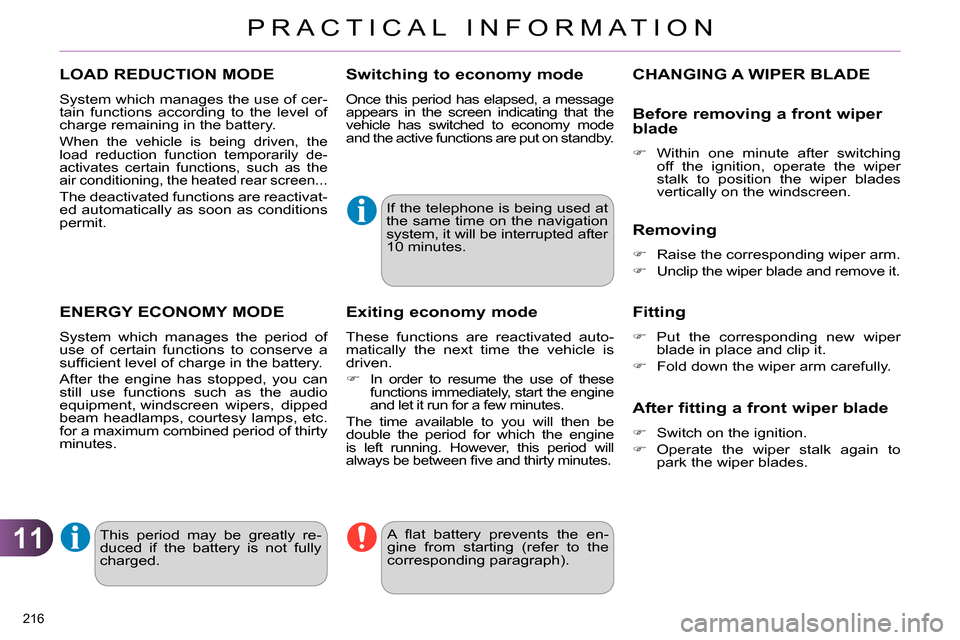
11
PRACTICAL INFORMATION
216
LOAD REDUCTION MODE
System which manages the use of cer-
tain functions according to the level of
charge remaining in the battery.
When the vehicle is being driven, the
load reduction function temporarily de-
activates certain functions, such as the
air conditioning, the heated rear screen...
The deactivated functions are reactivat-
ed automatically as soon as conditions
permit.
ENERGY ECONOMY MODE
System which manages the period of
use of certain functions to conserve a
suffi cient level of charge in the battery.
After the engine has stopped, you can
still use functions such as the audio
equipment, windscreen wipers, dipped
beam headlamps, courtesy lamps, etc.
for a maximum combined period of thirty
minutes.
Switching to economy mode
Once this period has elapsed, a message
appears in the screen indicating that the
vehicle has switched to economy mode
and the active functions are put on standby.
If the telephone is being used at
the same time on the navigation
system, it will be interrupted after
10 minutes.
A fl at battery prevents the en-
gine from starting (refer to the
corresponding paragraph).
Exiting economy mode
These functions are reactivated auto-
matically the next time the vehicle is
driven.
In order to resume the use of these
functions immediately, start the engine
and let it run for a few minutes.
The time available to you will then be
double the period for which the engine
is left running. However, this period will
always be between fi ve and thirty minutes.
This period may be greatly re-
duced if the battery is not fully
charged.
CHANGING A WIPER BLADE
Before removing a front wiper
blade
Within one minute after switching
off the ignition, operate the wiper
stalk to position the wiper blades
vertically on the windscreen.
Removing
Raise the corresponding wiper arm.
Unclip the wiper blade and remove it.
Fitting
Put the corresponding new wiper
blade in place and clip it.
Fold down the wiper arm carefully.
After fitting a front wiper blade
Switch on the ignition.
Operate the wiper stalk again to
park the wiper blades.
Page 219 of 340
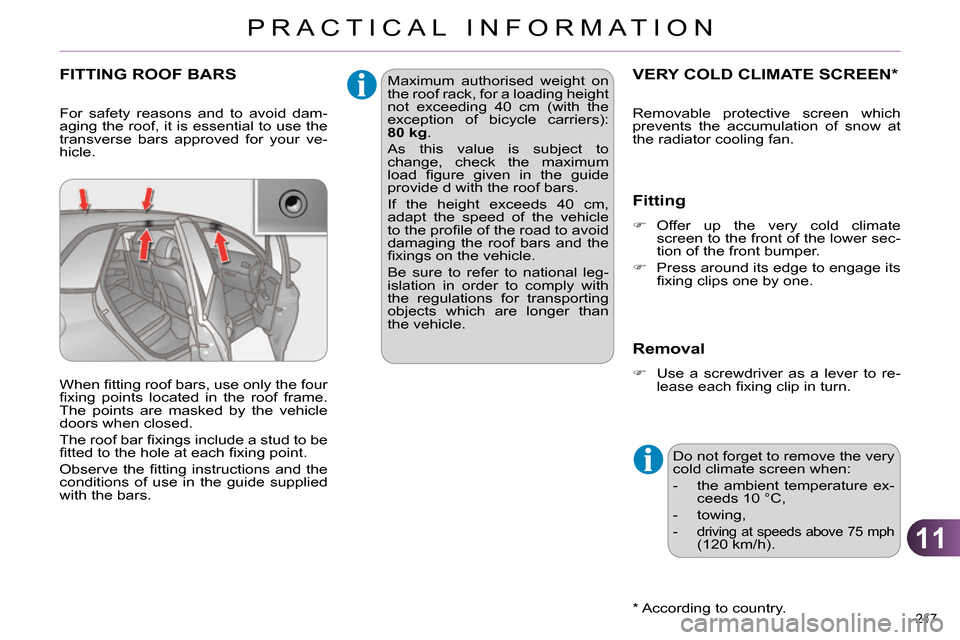
11
PRACTICAL INFORMATION
217
VERY COLD CLIMATE SCREEN *
* According to country.
Fitting
Offer up the very cold climate
screen to the front of the lower sec-
tion of the front bumper.
Press around its edge to engage its
fi xing clips one by one.
Removal
Use a screwdriver as a lever to re-
lease each fi xing clip in turn.
Do not forget to remove the very
cold climate screen when:
- the ambient temperature ex-
ceeds 10 °C,
- towing,
-
driving at speeds above 75 mph
(120 km/h).
Removable protective screen which
prevents the accumulation of snow at
the radiator cooling fan.
FITTING ROOF BARS
For safety reasons and to avoid dam-
aging the roof, it is essential to use the
transverse bars approved for your ve-
hicle.
When fi tting roof bars, use only the four
fi xing points located in the roof frame.
The points are masked by the vehicle
doors when closed.
The roof bar fi xings include a stud to be
fi tted to the hole at each fi xing point.
Observe the fi tting instructions and the
conditions of use in the guide supplied
with the bars.
Maximum authorised weight on
the roof rack, for a loading height
not exceeding 40 cm (with the
exception of bicycle carriers):
80
kg
.
As this value is subject to
change, check the maximum
load fi gure given in the guide
provide d with the roof bars.
If the height exceeds 40 cm,
adapt the speed of the vehicle
to the profi le of the road to avoid
damaging the roof bars and the
fi xings on the vehicle.
Be sure to refer to national leg-
islation in order to comply with
the regulations for transporting
objects which are longer than
the vehicle.
Page 220 of 340
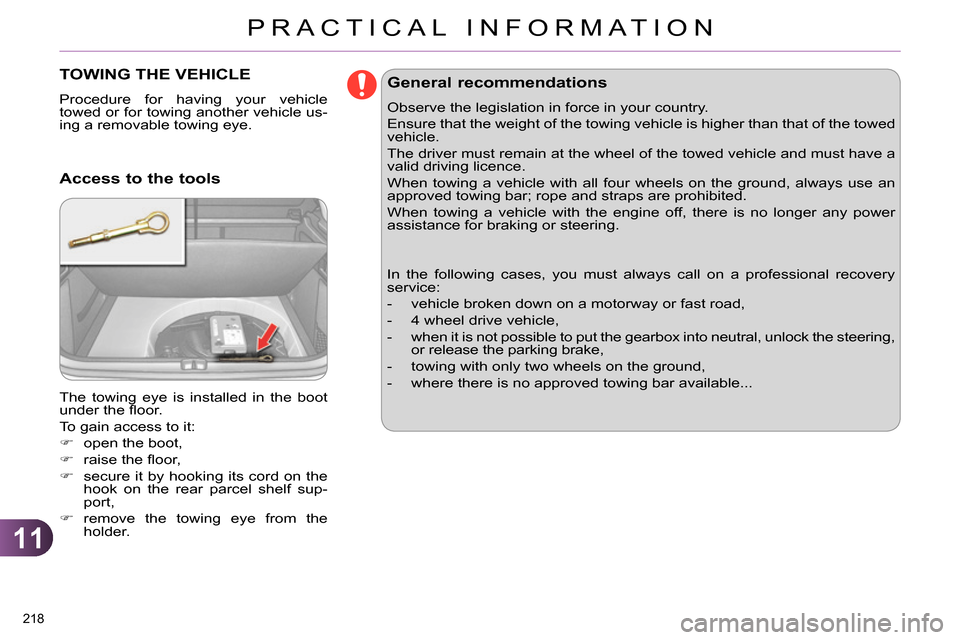
11
PRACTICAL INFORMATION
218
TOWING THE VEHICLE
Procedure for having your vehicle
towed or for towing another vehicle us-
ing a removable towing eye.
The towing eye is installed in the boot
under the fl oor.
To gain access to it:
open the boot,
raise the fl oor,
secure it by hooking its cord on the
hook on the rear parcel shelf sup-
port,
remove the towing eye from the
holder.
Access to the tools
General recommendations
Observe the legislation in force in your country.
Ensure that the weight of the towing vehicle is higher than that of the towed
vehicle.
The driver must remain at the wheel of the towed vehicle and must have a
valid driving licence.
When towing a vehicle with all four wheels on the ground, always use an
approved towing bar; rope and straps are prohibited.
When towing a vehicle with the engine off, there is no longer any power
assistance for braking or steering.
In the following cases, you must always call on a professional recovery
service:
- vehicle broken down on a motorway or fast road,
- 4 wheel drive vehicle,
- when it is not possible to put the gearbox into neutral, unlock the steering,
or release the parking brake,
- towing with only two wheels on the ground,
- where there is no approved towing bar available...